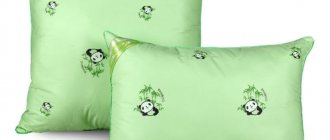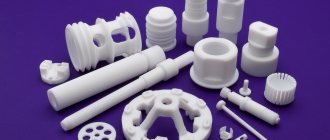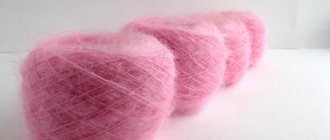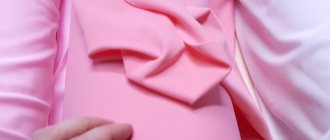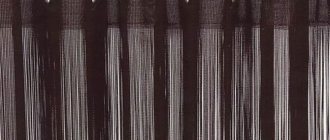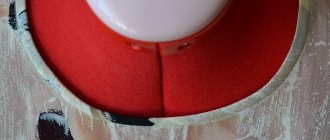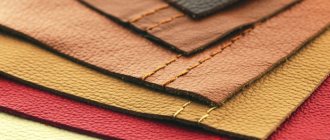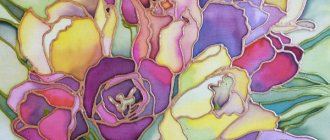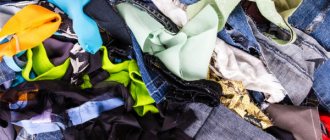Types of knitted fabric by weaving
- Kulirka . The thinnest knitwear. The front side consists entirely of braid loops. On the reverse side - all the loops are purl. The front surface is smooth, the material is the thinnest among the canvases.
- Interlock . It has two front sides, both covered with “braids”. The material is used in the production of children's clothing. It is distinguished by comfortable softness and moderately voluminous structure.
- Footer . Favorite material for tracksuits. On the front side it is covered with loops of “braids”. There are two types of footer:
- on the wrong side there is a “bouffant”, the material is dense and warm;
- wrong side – covered with air purl loops. Thinner material is used for summer sportswear.
Both types of footer are much denser than other types of knitted fabric.
- Pique . It looks like a waffle towel, but unlike it, it has the stretchability characteristic of knitwear. Used to make summer T-shirts with polo fasteners.
- Kashkorse . Low-cut sports trousers, cuffs, trowel collars – all this is cash-corse. The material is dense, made from cotton, wool, mixed fibers, knitted in the form of an elastic band - knit plus purl loops 2x2, 3x3.
- Ribana . Knitwear similar to cashkorse, only with a smaller pattern, knit and purl loops 1x1. Used for summer clothes or as cuffs, collars.
- Jersey . Dense wool material, does not wrinkle, stretches in the transverse direction. Even with the addition of other fibers, it does not lose its properties. A favorite material for women's dresses, skirts and suits.
- Knitted mesh . Widely used for lining, sportswear and underwear. Conducts air well.
- Biflex . The interweaving of threads takes place in two directions - horizontally and vertically. Made from synthetic fibers. The main difference is elasticity in two directions. Used for sportswear.
- Lycra . In its pure form, the material is not strong enough; it can be transparent or translucent. It is characterized by strong elongation, with virtually no residual deformation. In clothing it is used in combination with other fibers.
CLASSIFICATION AND RANGE OF KNITTED GOODS
Products produced by the knitting industry are characterized by a wide variety of assortments.
According to their purpose, all knitted products are divided into five groups: outerwear, underwear, hosiery, gloves, scarves and headwear.
By type of raw material, knitted products can be homogeneous (from one type of raw material) and heterogeneous (from different types of raw materials).
Homogeneous products are produced from yarn of natural fibers (cotton, wool, etc.), from yarn or threads from artificial fibers (viscose, acetate, etc.), from yarn or threads from synthetic fibers (nylon, nitron, etc.).
Heterogeneous products include products made from yarn of natural fibers mixed with chemical fibers or in combination with yarn or threads made from chemical fibers.
Depending on the structure of the fabric, knitted products can be knitted (single and double) and warp knitted (single and double).
According to the manufacturing method, knitted products are distinguished: knitted (regular and semi-regular), cut from knitted fabrics and combined (from knitted and cut parts).
According to the method of finishing and processing of fabrics, products can be harsh, boiled, bleached, dyed, variegated, printed, brushed, finished in suede, velvet, embossed, polished, with a base, with various structural effects (grained structure, with relief scars, patterns, boucle, tweed, plush, with crepe effects under chiffon, under crepe georgette, crinkle effects, imitation hand knitting), with special treatments.
In the trade classification, knitted products are divided according to their intended purpose into the five groups mentioned above. In each group, products are divided into subgroups depending on the gender and age of consumers: men's, women's and children's. In the groups of underwear and hosiery, there are also subgroups of sports products. Products of each subgroup are divided into types. In the trade classification, types of products are divided according to the composition of raw materials, weave, complexity and style features.
The style of a knitted product is characterized by the following features: silhouette, type of product design, cut and length of sleeves, design and shape of the collar and the nature of the neck design, type of fastener, pocket design, type of processing of the hem and low sleeves, pattern of the knitted fabric.
According to the silhouette, all outer knitwear products are fitted, semi-fitted, straight and loose.
The type of structure is determined by the method of dividing the surface of the product (mill) into main parts.
The last stage of classification is the article - a symbol of a product that differs from others in the style, type and linear density of the yarn (threads) from which the fabric of this product is made, the type of weave, the type of knitting machine on which it is produced.
Outer knitted products are made from various types of raw materials. Almost all types of knitted fabrics are used, with preference given to double fabrics with a shape-stable structure. These are, as a rule, fabrics with a high surface density (up to 470 g/m2 or more), non-unraveling, and low-stretch.
Outer knitwear, in addition, is grouped according to other criteria: by gender and age - into men's, women's and children's clothing (for boys and girls of school, preschool and nursery ages); by purpose - for home, casual, dressy, sports and leisure wear; by season - for summer, winter, demi-season (autumn-winter and spring-summer) and off-season products; according to the degree of fit to the figure - into products of adjacent, semi-adjacent, straight and free silhouettes; by type - for coats, short coats, capes, jackets, jackets, cardigans, jumpers, vests, sweaters, overalls, bib overalls, dresses, dressing gowns, blouses, blouses, top shirts, trousers, shorts, skirts, leggings, suits, pajamas, and also according to their varieties.
As you can see, many types of knitted products are similar to the corresponding types of garments.
The range of outerwear for adults is varied.
A coat is a shoulder-length garment with sleeves, with a slit or fastening from top to bottom, for outdoor wear. They are made from knitted fabrics duplicated with foam rubber, which increases their heat protection. In trade practice, such coats and other products made from warp-knitted (many threads) knitwear are called jersey (from the English jersey - from the name of the island of Jersey).
Jackets are products with sleeves and a slit along the entire length of the body, consisting of a back and two shelves. The waist of the jacket, depending on the style, is either seamlessly knitted or stitched; the back and front panels can consist of one or several parts. Women's jackets are made with long, semi-long and short sleeves, men's - only with long ones. The sleeves of the jackets are sewn in, one-piece and raglan, of various lengths and widths. The bottom of the sleeves ends with wristbands, cuffs or a border, but can be sewn with a machine seam with a hem. The bottom of the jacket ends with a single or double machine-made border, a single or double ribbed weave belt or a sewn-on belt. A type of jacket is a blouson.
A jumper is a product without a cut or with a cut that does not reach the end of the waist. They produce jumpers such as shirts or sweaters. A jumper consists of a back, a front, long, semi-long or short sleeves and a collar, or maybe without a collar. The jumper's body is either seamlessly knitted or stitched. The bottom of the waist ends in the same way as the jacket.
A type of jumper is a pullover (from the English pull-over - to put on over the head), which is distinguished by a solid waist, a large wedge neckline, and the absence of pockets.
A vest is a product with armholes, sleeveless and a slit along the entire length of the waist. It consists of a back and two shelves, fastened with buttons, buckles or a zipper. The clasp can be single-breasted or double-breasted. Vests come with a single, double collar or without a collar, with pockets of various configurations and without them. The collar, shelves and armholes of the vest are trimmed with trim or border, the bottom of the vest is folded inward or finished with an eraser.
A sweater (from the English sweater sweat - to sweat) is a product consisting of a waist, sleeves and a high collar (more than 5 cm), completely covering the neck, without fasteners, worn over the head.
A turtleneck is a type of sweater with a high collar made from fine yarn.
Leggings - waist clothing that tightly fits the lower part of the body and legs to the feet, each separately, consists of a torso and legs, separately knitted or cut, a gusset and straps. A variety of leggings are shortened leggings with a trace.
Capri is a waist-length garment that fits the lower torso and legs to mid-calf, each individually.
Leggings are waist-length clothing that tightly fits the lower torso and legs to the ankle, each individually.
Sports suits consist of trousers and a jacket or a sweater, jumper, jacket.
Women's suits are made from a variety of raw materials in various weaves. They produce two-piece suits and three-piece suits. A two-piece suit consists of a jacket or jumper and a skirt, a three-piece suit consists of a jacket, jumper and skirt (trousers).
Daytime pajamas are made for men and women. Men's pajamas consist of a jacket or jacket and trousers, women's pajamas consist of a jacket and trousers or a blouse and trousers. They are produced mainly from plated and single brushed fabric, from cotton, wool blend and viscose yarn.
Vodi is a shoulder-length garment for women and girls, tight-fitting to the body, consisting of a bodice with sleeves (or sleeveless) and panties combined into one piece, worn over corsetry or directly on the body.
Top - shoulder-length clothing for women and girls, covering the torso partially or completely, without sleeves, with straps (or without them), with a fastener (or without it), worn on corsetry or directly on the body.
Combidress (from the German Kombidress - combined T-shirt, T-shirt), body shorts (from the English body - body, bodice, short - short), body suit (from the English bodysuit - sports suit) - women's and girls' clothing, tightly fitting to the torso and hips, consisting of a bodice (blouse, T-shirt or sweater) with sleeves (or sleeveless) and panties combined into one, intended for sports. The front gusset is fastened with buttons, snaps or hooks. The product is one-piece, i.e. no seam along the waistline. Made from elastic knitwear. Depending on the design and material, it can be used as underwear and as outerwear, complete with a skirt, trousers, jacket.
The range of outerwear for older children includes the same types of products as for adults, but in less complex styles. Outerwear for preschool children - coats, jackets, dresses, overalls, blouses and capes, suits.
Coats are made in two types: with a hood or cap, or with a collar. Hoods are sewn on and can be fastened or tied under the collar. Turn-down collar - solid or stitched. The coat is finished with linen, embroidery, stitching or appliqué.
The drape consists of a cape and a hood. The cape is straight or flared, solid or stitched. Drapes are made from the same fabrics as coats.
Dresses are made in various styles - wide at the bottom and close-fitting at the waist, with and without sleeves, with various trims. Dresses can be produced in a set with pants.
Children's suits are made in three types: 1) for boys: short pants (shorts) or long or semi-long trousers and one of the following items - a jumper-pullover, a vest, a jacket, a shirt, a jacket, a blouse; 2) for girls: a skirt or long trousers and one of the following items - a blouse, jacket, jumper-pullover, vest; 3) for boys and girls: leggings and a sweater or pullover jumper. Costumes can be produced as sets - together with a hat, scarf, mittens, etc. Children's suits are made from various yarns and threads, varied in weave and color, with fabric trim, patterned braid, machine stitching, embroidery, appliqué, etc.
Blouses are shoulder-length clothing with sleeves, a fastener, covering the torso partially or completely, for preschool children.
The production of children's products made from knitted fabrics using chemical fibers must be approved by the Ministry of Health.
Knitted underwear is produced from all types of raw materials. For the production of most underwear, in contrast to outer knitwear, thinner knitted fabrics with a lower surface density of a wide variety of main and patterned weaves are used. In addition, printed knitted fabrics and various finishing materials, primarily lace, are widely used.
Knitted underwear is divided according to a number of criteria: according to gender and age - men's, women's, teenage and children's (for newborns, toddlers, preschool and school ages); by purpose - household and sports; by season - autumn-winter and spring-summer; by production method - cut, regular and semi-regular; by size and height, i.e. along the length of the product; for finishing - bleached, plain-dyed, printed and variegated, with antifungal, antibacterial, antiallergic, antistatic and other special treatments; by type of product - sweatshirts (underwear, sports, etc.), underpants, shirts, pantaloons, combinations, night shirts, men's and children's shirts, petticoats, briefs, T-shirts, swimsuits, pajamas, negligees, vests, rompers, envelopes, sandboxes, etc.
The style of a knitted underwear product is determined by the following main features: silhouette, type of construction, cut and length of sleeves, design and shape of the collar, the nature of the design of the neck, the type of fastener, the nature of the processing of the bottom of the waist and low sleeves. According to the silhouette, underwear can be adjacent, semi-adjacent, straight and widened downwards; according to the design of the camp - seamlessly knitted and sewn at the sides. The cut of the sleeves is most often set-in and raglan, long and short. Collars of linen products can be turn-down of various shapes, stand-up, or seamlessly knitted. The neckline of products without a collar can have different shapes, depths and finishes (trimming from the main or finishing fabric, lace, piping, etc.). The fastener of knitted underwear can be of different lengths (sometimes through from top to bottom) and type - buttons, zippers. The bottom of the waist and sleeves, depending on the purpose and style of the product, is treated with a hem seam, a sewn double or single elastic waistband, and trimmed with lace from the main or finishing fabric. Linen products can also differ in the patterns of the knitted fabrics used, the presence of pockets, trims, etc.
Household knitwear is distinguished by its diversity.
The range of men's underwear includes sweatshirts, underpants, long johns and overshirts.
Sweatshirts are produced in two types: with a fastener and without a fastener. Both types of sweatshirts can be with long and short sleeves, as well as sleeveless. The bottom of a long sleeve ends with a rib or cuff, while a short sleeve ends with a cuff or a folded edge inward.
Underpants are worn over underwear.
There are two types of long johns by design: long and short. They are sewn from the same knitted fabrics (in terms of raw materials and weave) as sweatshirts. The top of the long johns is made with a sewn-on fabric belt, fastened with buttons at the front; close the top with a side with an elastic band. The bottom of the legs of long johns ends with a sewn single or double eraser. The edges of short pants are hemmed inside.
Sweatshirts together with long johns make up the set.
Overshirts are made in three types: with long sleeves ending in single cuffs with one or two buttons; with short sleeves, the bottom of which is folded inward or trimmed with a placket, piping, or trim; with short sleeves (these shirts are worn untucked). The waist of the shirts can be solid or sewn at the sides, with a slit in the front to the end or not to the end of the waist. The bottom of the waist is folded inward and hemmed.
Undershirts are clothes with sleeves, without a collar, covering the torso and part of the hips.
Polo is a sports shirt with a soft turn-down collar and a fastener to the middle of the chest.
The Lacoste shirt is a sports shirt with a polo collar and fastening, with short sleeves ending in elastic. It was patented in 1933 by the French tennis player R. Lacoste, who came up with the idea of sewing a crocodile emblem on the chest of a tennis shirt.
T-shirt is an overshirt with short sleeves and a polo closure.
T-shirt (from English, T-shirt - short sleeves and waist resemble the letter “T”) - a knitted shirt with a round collar and short sleeves.
Night pajamas are a set of sleepwear consisting of a jacket (sweatshirt, blouse, T-shirt) and trousers (shorts) of various lengths.
Women's underwear includes shirts, pantaloons, slips, skirts, negligees, sets, and pajamas.
There are three types of day shirts: semi-fitting, widened downward; with an expanded waist from top to bottom; with a straight stance. Shirts of each type can be of two types: with sewn-on or one-piece straps or with sleeves. Shirts of the 1st and 2nd types have a seamed waist, while shirts of the 3rd type have a seam that can be seamlessly knitted or stitched. Depending on the style, the front and back of the shirts are solid or pieced, smooth or with a yoke, pleats, darts, toes, and a trimmed bodice.
Undershirts are clothes with sleeves or sleeves, without a collar, covering the torso and legs partially or completely.
Nightgowns are produced in three types: with sewn-in sleeves; with one-piece raglan sleeves; without sleeves.
The waist of nightgowns can be straight, widened at the bottom or narrowed at the waist, with a trimmed bodice, folds, and darts. According to the length, shirts are long (to the middle of the shin) and short (to the knees). The neckline can be of any configuration, with or without a slit, with a fastening (most often to the waist) with buttons or ribbon. Sleeves short or long.
Combinations are elegant clothing that covers the torso and legs partially or completely, without sleeves or collar, with an open back and upper chest, with straps. They are usually made from artificial or synthetic fabric of two types: semi-adjacent, widened downwards or straight; with a camp expanded from top to bottom. If the combination of the first type is strapless, then the elastic band is threaded into the edge of the top or attached in several rows. Decorated with lace, lace braid, etc. They differ from shirts in silhouette, raw materials, finishing and slightly longer length.
Camisole (from the French camisole - vest) is a short slip, cut under the bodice, as in the “empire” style, usually slightly flared due to the fact that the fabric is gathered under the bust line.
Night pajamas consist of a blouse and pajama pants, and can be with or without a collar, with long, short or sleeveless sleeves.
Bustiers are designed to shape and support the mammary glands, but do not have rigid shapes.
A cover is an undershirt made of opaque fabric, worn under a transparent light dress.
Knickers (from Italian Pantaloni - shortened trousers) - underwear covering the lower part of the figure. By design there are three types: long, short and pantaloons. The pantaloons consist of two legs and a gusset (may be without it). The upper part of the pantaloons is called the torso.
Slip panties - closed at the back; thong - open at the back; Kulot - closed both in front and behind, but wider than the slip, thereby visually enlarging the hips; Brazilian slip - closed at the back, but narrower at the front than the slip; devan-derer - have the same narrow shape in front and back.
Skirt-panties - women's underwear that combines a skirt and panties. Especially comfortable under clothes that fit your figure.
Petticoats are worn under a skirt or dress, usually made with frills or flounces, with a wrap, and with various trims along the bottom.
Peignoir (from the French peignoir - to comb) is an elegant morning dress that covers the torso and legs partially or completely, with or without sleeves, with a slit or fastener from top to bottom, worn over sleepwear. Peignoirs are sewn in a loose silhouette, with or without lining; they can be included with a nightgown.
Sets are sets of women's underwear made of the same fabric, the same size, with the same finish. They consist of a shirt and pantaloons, a slip and pantaloons, a bra, pantaloons and a skirt. Sets for young people can consist of a skirt, bikini-type panties, as well as a shortened combination and panties.
The range of children's underwear is quite wide; it is divided into underwear for older children and toddlers.
Underwear for older children can be divided into underwear for boys and underwear for girls. The range of this underwear includes the same types of products as for adults.
For boys they produce sweatshirts, long johns, and shirts. They are made from fabrics of the same types and types as products for men. They differ only in smaller sizes—from 52 to 92—and in the fact that products of each size are sewn of the same height.
The range of lingerie for girls includes pantaloons, slips, nightgowns, which differ from the same products for women in sizes (from 52 to 92). Underwear for girls of each size is produced in one height (length).
Linen for toddlers - baby vests, rompers, sandboxes, as well as overalls, envelopes, aprons, bibs, booties, drape, diapers, etc.
Baby vests are free-form underwear for newborns with sleeves, a slit from top to bottom in the upper part of the front or on the back. Their sizes are from 40 to 48.
Shirts, unlike vests, have a slit in the upper part of the front or back.
Rompers are divided into three types: 1) rompers with or without a trace - on straps with or without a breast, with a bodice and on an elastic (rubber) band; 2) one-piece; 3) envelope slider - one-piece, sleeveless, with or without a front clasp. Sizes - from 44 to 52.
Sandboxes: 1) panties like swimming trunks with straps with and without breasts or with a bodice and elastic (rubber) band; 2) one-piece (swimming trunks). Sandboxes are also produced in the form of a set - strapless panties and a blouse. Sandbox sizes are from 24 to 30.
Sleeping overalls are made one-piece, cut at the waist, with legs (long - with a trace and without a trace, cropped or short), with sleeves (of various lengths) and without sleeves. Sizes - from 52 to 64.
Envelopes for newborns are divided into two types: 1) with sleeves and a front clasp; 2) sleeveless and with a front closure. They can be with or without a sewn or fastened hood, with a zipper, buttons or ribbons. Sizes: 44 and 48.
Booties are a product for newborns and toddlers that cover the lower part of the leg, including the ankle.
Aprons can have straps or have ties at the neckline.
The cape has the appearance of a straight or flared cape.
Sports underwear includes T-shirts, briefs, singlets, swimsuits, tights for weightlifters, gymnasts and wrestlers, and shirts for cyclists.
T-shirts are shoulder-length products, produced without sleeves, collar or fastener. Both types of jerseys can be one-piece or seamed at the sides, with one-piece or seam at the shoulders. The neckline is larger in the front than in the back.
Sweatpants end with an elastic band, cuff or stripe.
The panties are produced in regular (with and without gusset) and shortened (swimming trunks). They produce several types of sports shorts: regular shorts, swimming trunks for swimmers, shorts for cyclists, shorts for water polo, etc.
Sweatshirts come in two types: they are tucked into trousers or a skirt, or worn untucked. The body of the sweatshirts is one-piece or sewn at the sides. The bottom of the waist is folded, hemmed or finished with a sewn double belt, trim strip or trim. Sleeves are long or short, sewn in or one-piece.
Marine sweatshirts (vests) are made from variegated cross-striped fabrics with blue stripes. The neckline is deeper than regular sweatshirts, without fastening, with long, short or sleeveless sleeves.
Swimwear fits tightly around the torso at the chest, waist and hips. They are made in several types: X) with a solid waist, with hangers cut together with the waist or with or without shoulder straps; 2) panties and bra; 3) panties.
Hosiery products are made from fibers and threads of a relatively narrow range: nylon monofilaments and complex threads of regular and modified structure, cotton, wool yarn, mixed yarn of various fibrous compositions, elastic spandex threads and rubber vein.
The standards regulate the use of other types of threads (fiber composition, linear density and other indicators).
To produce hosiery, various types of knitted weaves are used, but most often - knitted stitch, smooth patterned plated fabrics, pressed, jacquard, etc.
Hosiery is divided: according to gender and age - men's, women's, teenagers and children's; according to the production method - round (seamless), cotton from cross-knitted fabrics (with a longitudinal seam) and cut from warp-knitted fabrics; by purpose - casual, smart and sporty; for finishing - bleached, plain-dyed, printed and variegated, with decorative elements (piece printing, bows, pompons, etc.), with antifungal, antibacterial, antiallergic, antistatic and other special treatments; by size; by type of product ~ stockings, half-stockings, socks, underwear, tights (leggings-stockings), leggings.
Women's stockings cover the legs and part of the thighs. The main parts of a woman's stocking are the side, leg, heel, trail and toe. They can be knitted on round (without a seam or with a false seam) and flat machines (with a seam), and can also be made cut from knitted fabric. The most common stockings are those produced on circular hosiery machines.
Children's stockings are somewhat different in structure from women's stockings and consist of an eraser, leg, heel, footprint and toe. The eraser of children's stockings is knitted with a double-face (rubber) weave, which gives the stocking good stretch and elasticity. The width of the eraser is the same along its entire length. At the bottom, the eraser turns into a 3 cm long leg, which is usually knitted in satin stitch. The heel is made low, with a reinforcing thread, the trail is knitted without reinforcement, and the toe is knitted with reinforcement; for products starting from size 16, nylon is used. Half-stockings cover the feet and lower legs up to the knee; they differ in design from stockings - they have a shorter leg.
Tights (leggings with a trace) cover the lower part of the body and the legs completely, including the feet, consist of a torso with a side, legs, heels, a trace, toe, gusset.
Tights are divided into women's and children's.
Tights for their intended purpose can be classic, decorative, warm, therapeutic and health-improving, and figure-correcting. Tights can be with a padded toe, a gusset, a bikini pad, panties, shorts, or panties pads of various shapes, with a flat seam on the torso, and with a double seam on the buttocks.
Tights can contain cotton in seals, which allows them to be worn without underwear, as well as LYKRA elastane fiber (Lycra), introduced using various technologies. If the lycra content is from 3 to 7%, this means that it is contained only in the most highly stretchable parts of the tights, i.e. in a belt, “panties” or “shorts”, and the actual legs of the tights consist of polyamide. In such models, quite often there is an unpleasant feeling of tights “sagging” on the knees and not fitting tightly to the leg.
Lycra content from 8 to 25% indicates that it is evenly distributed in the tights, and such tights will fit the figure well.
Lycra content of 25 to 30% is typical for tights with medical effect. They fit the leg very tightly along the entire length, support the muscles and at the same time stimulate blood circulation in the legs, allowing you to avoid dangerous blood stagnation.
The thread density can be from 5 to 120 DEN (weight in grams of a thread 9 km long).
Culottes are men's hosiery that covers part of the torso and legs to the foot (or the upper parts of the legs to the knee and the upper parts of the legs and part of the lower leg), each separately.
Hosiery leggings are a product for women or children that covers the lower part of the torso and legs to the foot, or the upper parts of the legs to the knee, or the upper parts of the legs and part of the lower leg, each separately.
The heels cover the feet completely, consist of a body and a side with a rubber thread, and are made from elastic thread.
Semi heels cover the fingers and partially the soles of the feet,
Socks cover the feet and lower legs, including the ankle. They produce men's, women's and children's socks. The following parts are distinguished in socks: eraser (side), leg, heel, footprint and toe. The eraser is knitted in a two-face (elastic) weave. Its length, depending on the design and size of the socks, is from 2 to 12 cm. Socks are produced with a short eraser - 2-3 cm, which is called a side. The border is knitted with rubber or polyurethane thread, which gives it elasticity. The erasers of men's socks are usually one-color, while women's and children's socks are variegated with a colored border. Women's and children's socks, as a rule, have shorter legs, usually plain or with a pattern - transverse colored stripes, while men's and teenagers' socks have longer ones. Men's, women's and teenagers' socks usually have a high heel, while children's socks usually have a low heel.
Sports products include half-stockings, leg warmers, knee pads and ankle pads.
Sports half-stockings cover the feet and lower legs up to the knee. They are made with smooth, pressed or embossed padding, thicker and heavier than household ones to protect the legs from bruises. The top of the pagolenka ends with a side with a rubber thread or a lapel. Half-stocking sizes are from 21 to 29, length - to the knees.
Leg warmers are stockings or half-stockings that do not cover the feet, ending at the top with an eraser or cuff, and at the bottom with an eraser to which a strip is sewn. Leg warmer sizes: 8, 10 and 12 (determined by the width of the leg in centimeters at a distance of 15 cm from the beginning of the upper eraser).
Gloves are made from natural (wool and cotton) and chemical fibers in pure form or in various combinations. Most often, wool, cotton, viscose and nylon fibers and threads made from them of regular and modified structure are used. Gloves are divided into: according to the type of weave - from smooth weave without fleece or with fleece, single or double weave, fillet, jacquard, etc.; by gender and age - male, female and children; by production method - knitted and sewn; in terms of finishing - bleached, plain-dyed, printed and variegated, with suede, leather, embossed and polished finishes; by purpose - everyday and sports; socks by season - winter, demi-season and summer; by size; by type - gloves, mittens and mittens.
The size of the glove is determined by the girth of the hand in centimeters, measured in the middle between the bases of the thumb and index finger.
Gloves made of knitted fabric (sewn) are of two types in design: with a rectangular hem and a hem widened downwards. Sewn gloves consist of a body with four fingers, a thumb and interdigital strips (arrows). Fasten the gloves with snaps, buttons, buckles, and Velcro fasteners.
Knitted gloves are made single or double of two types: 1) five-fingered and 2) two-fingered. They consist of a body, fingers and a wristband. Wristbands are knitted in rectangular and shaped shapes.
Mittens made of knitted fabric (sewn) are produced in one type - single-fingered. The top and lining of the mittens consist of a body and a thumb, which can be sewn in or with a sewn-on upper part. Mittens can have different clasps.
Knitted mittens are made single and double; they partially cover the forearm, the palm of the hand, four fingers together and the thumb separately, or three fingers together, and the thumb and index separately. Mittens are a type of mittens.
The mittens cover part of the forearm, the palm of the hand and five fingers together for newborns and toddlers.
For hats and scarves, combed and carded yarns, complex artificial and synthetic threads are often used. Hats and scarves are divided: according to gender and age - men's, women's and children's; by production method - regular, semi-regular and cut; by season - winter and summer; for finishing - bleached, plain-dyed, printed and variegated; by design - single, double with and without fringe, with and without additional trim; by types and sizes.
The group of shawl-scarf products includes shawls, kerchiefs, scarves, hats, berets, helmets, balaclavas, bonnets, pareos, etc.
Shawls, depending on the type of raw material and weave, are divided into winter, demi-season and summer. They are produced in square shapes, cross-knitted and warp-knitted weaves, from high-volume yarns and threads, synthetic threads, mixed and woolen yarns, from goat down with cotton yarn, with fringe and with a border without fringe. The size of scarves is set without taking into account the length of the fringe.
The scarf has the shape of a triangle.
Scarves are usually made in rectangular shapes, single or double, from various types of yarn. Their length and width are measured in the middle of the product, excluding tassels and fringe. Scarves measuring 150 x 50 cm or more are called stoles.
The hats fit tightly around the head. For adults they produce sizes 52-60, for children - 44-50. Hats for adults and children are made from various yarns; according to the production method, they can be knitted or cut.
Berets are headdresses without round or oval brims.
The helmet fits tightly around the head and covers the ears.
The liner is designed to be worn under helmets or helmets.
The newborn cap fits snugly around the head, with ties under the chin.
Ilapeo is a shawl-scarf item tied around the body as an addition to a swimsuit or bathing suit.
Interlock
Interlock is often called “dvulastic”; it is a knitted fabric with an “elastic” structure. Smooth on both sides. Doesn't stretch. Doesn't bloom. Resistant to deformation. Warm. Good air permeability. Effective. Used for sewing knitted underwear, light summer clothes, shirts, sportswear, children's clothing. 100% cotton.
- Cashkorse fabric with many varieties: their features and applications
Raw materials for knitted products
The quality of knitted products primarily depends on the selected raw materials. Today, sewing enterprises use almost all possible varieties of fibers to produce knitwear, including not only natural, but also synthetic ones.
The structure of knitwear is a system of loops that are interconnected in the longitudinal and transverse directions. The threads themselves that make up the weave of knitted fabric consist of different fibers - short and long. Depending on the type of fiber, three types or groups of products are distinguished:
- From yarn - short twisted fibers
- Made from threads - long fibers with different types of twist
- From various combinations of yarn and long threads
